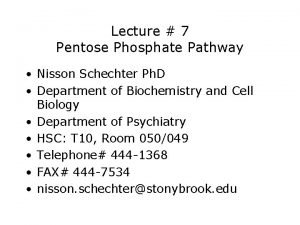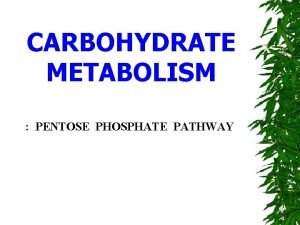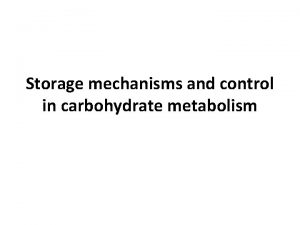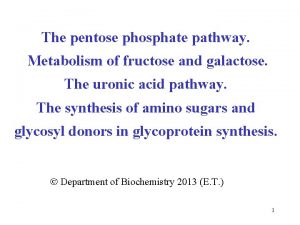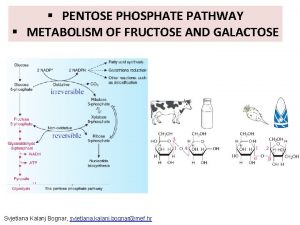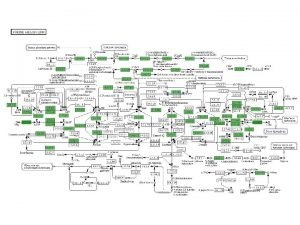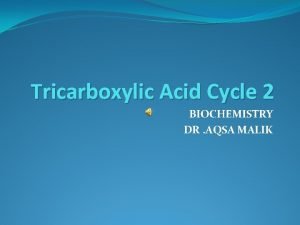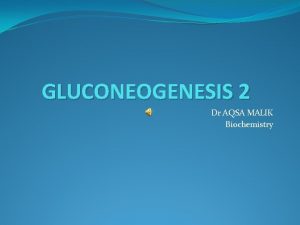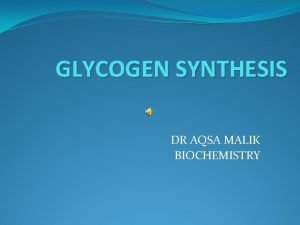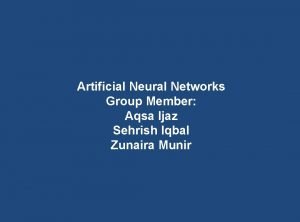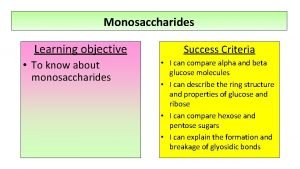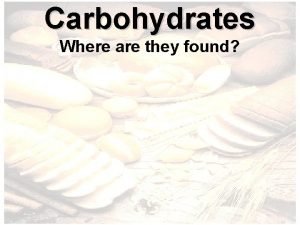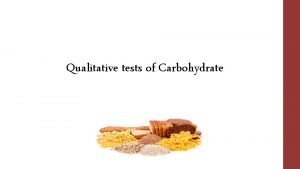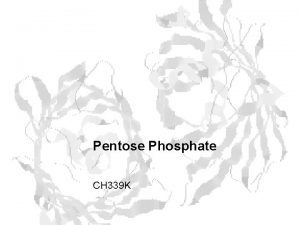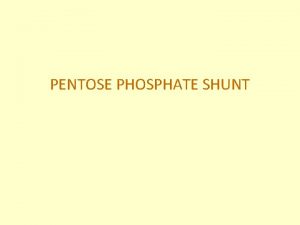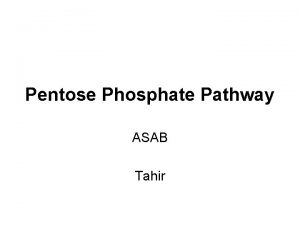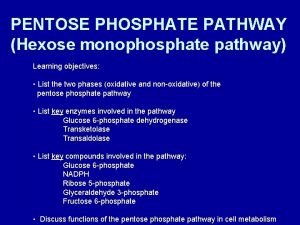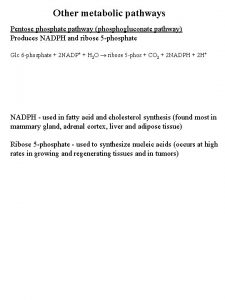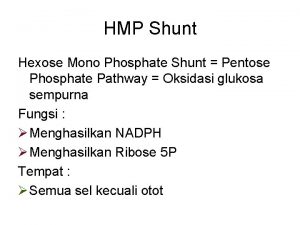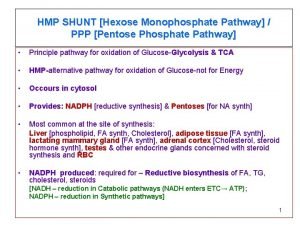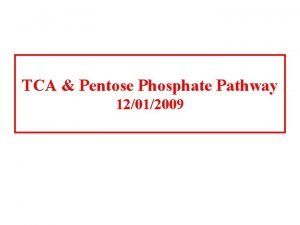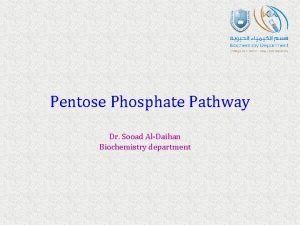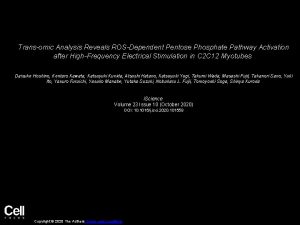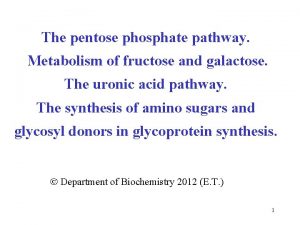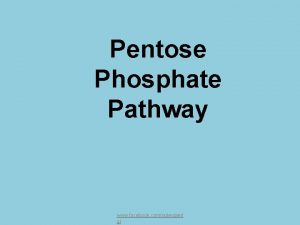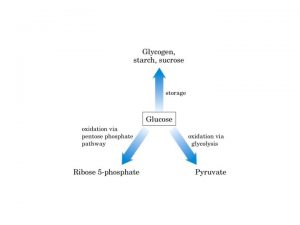Pentose Phosphate Pathway 1 DR AQSA MALIK Overview





























- Slides: 29

Pentose Phosphate Pathway 1 DR AQSA MALIK

Overview ü The pentose phosphate pathway is also called Hexose Monophosphate Shunt or Phosphogluconate Pathway. ü It is an alternate route for the oxidation of glucose without direct consumption or generation of ATP. ü It takes place entirely in the cytoplasm.

Tissues Requiring The Pathway Oxidative portion of the pathway is particularly important in the liver, lactating mammary glands, and adipose tissues, which are active in the biosynthesis of fatty acids. In the adrenal cortex, which is active in the NADPHdependent synthesis of steroids. In erythrocytes, which require NADPH to keep glutathione reduced. The nonoxidative reactions of the pentose phosphate pathway occur in all cell types synthesizing nucleotides and nucleic acids

Biomedical Importance No ATP is directly consumed or produced in the cycle. The pathway provides a major portion of the body's NADPH, which functions as a biochemical reductant. It also produces ribose 5 -phosphate, required for the biosynthesis of nucleotides Produces intermediates for glycolysis. provides a mechanism for the metabolic use of five-carbon sugars obtained from the diet or the degradation of structural carbohydrates in the body

Importance of pentose phosphate pathway : ü Generation of NADPH ‐ mainly used for reductive synthesis of fatty acids, cholesterol and steroid hormones. ‐ hydroxylation reaction in metabolism of phenylalanine and tryptophan. ‐ production of reduced glutathione in erythrocytes and other cells. ü Production of ribose residues - used for nucleotide, nucleic acid , and coenzyme biosynthesis ü Serves as an entry into Glycolysis for both 5‐carbon & 6‐carbon sugars.

Uses of NADPH 1. Reductive synthesis of fatty acids, cholesterol and steroid hormones. 2. Reduction of hydrogen peroxide 3. Cytochrome P 450 monooxygenase system 4. Phagocytosis by white blood cells 5. Synthesis of nitric oxide

Reduction of Hydrogen Peroxide Hydrogen peroxide (H 2 O 2) is one of a family of reactive oxygen species(ROS) that are formed from the partial reduction of molecular oxygen. These compounds are formed continuously as byproducts of aerobic metabolism, through reactions with drugs environmental toxins when the level of antioxidants is diminished, all creating the condition of oxidative stress.

The highly reactive oxygen intermediates can cause serious chemical damage to DNA, proteins , and unsaturated lipids and can lead to cell death. ROS have been implicated in a number of pathologic processes , including reperfusion injury, cancer, inflammatory disease , and aging. The cell has several protective mechanisms that minimize the toxic potential of these compounds.

Reduction of Hydrogen Peroxide Reduced glutathione, a tripeptide-thiol (γ-glutamylcysteinylglycine) present in most cells, can chemically detoxify hydrogen peroxide This reaction catalyzed by the selenium-requiring glutathione peroxidase, forms oxidized glutathione, which no longer has protective properties The cell regenerates reduced glutathione in a reaction catalyzed by glutathione reductase, using NADPH as a source of reducing electrons

Erythrocytes are totally dependent on the pentose phosphate pathway for their supply of NADPH because, unlike other cell types, erythrocytes do not have an alternate source for this essential coenzyme



Cytochrome P 450 monooxygenase system Monooxygenases incorporate one atom from molecular oxygen into a substrate (creating a hydroxyl group), with the other atom being reduced to water. In the cytochrome P 450 monooxygenase system, NADPH provides the reducing equivalents required by this series of reactions. The overall reaction catalyzed by a cytochrome P 450 enzyme is : R-H + O 2 + NADPH + H+ → R-OH + H 2 O + NADP+ where R may be a steroid, drug, or other chemical. This system performs different functions in two separate locations in cells.

Mitochondrial system: P 450 monooxygenase system found associated with the inner mitochondrial membrane is the biosynthesis of steroid hormones. In steroidogenic tissues, such as the placenta , ovaries, testes, and adrenal cortex, it is used to hydroxylate intermediates in the conversion of cholesterol to steroid hormones, The liver uses this same system in bile acid synthesis and the hydroxylation of cholecalciferol to 25 -hydroxycholecalciferol and the kidney uses it to hydroxylate vitamin D 3 to its biologically active 1, 25 -dihydroxylated form.

Microsomal system: An extremely important function of the microsomal cytochrome P 450 monooxygenase system found associated with the membrane of the smooth endoplasmic reticulum is the detoxification of foreign compounds (xenobiotics). These include numerous drugs and such varied pollutants as petroleum products and pesticides. CYP enzymes of the microsomal system , can be used to hydroxylate these toxins. The purpose of these modifications is two-fold. First, it may itself activate or inactivate a drug and second, make a toxic compound more soluble, thereby facilitating its excretion in the urine or feces.

Phagocytosis by white blood cells �Phagocytosis is the ingestion by receptor-mediated endocytosis of microorganisms , foreign particles , and cellular debris by cells such as neutrophils and macrophages (monocytes). It is an important defense mechanism, particularly in bacterial infections. Neutrophils and monocytes are armed with both oxygenindependent and oxygen-dependent mechanisms for killing bacteria.

� Oxygen-independent mechanism: Oxygen-independent mechanisms use p. H changes in phagolysosomes and lysosomal enzymes to destroy pathogens. Oxygen-dependent system: Oxygen-dependent mechanisms include the enzymes NADPH oxidase and myeloperoxidase (MPO) that work together in killing bacteria.

An invading bacterium is recognized by the immune system and attacked by antibodies that bind it to a receptor on a phagocytic cell. After internalization of the microorganism has occurred, NADPH oxidase, located in the leukocyte cell membrane, is activated and reduces O 2 from the surrounding tissue to superoxide(O 2– • ), a free radical, as NADPH is oxidized.

The rapid consumption of O 2 that accompanies formation of O 2– • is referred to as the“respiratory burst. ” Active NADPH oxidase is a membrane associated complex containing a flavocytochrome plus additional peptides that translocate from the cytoplasm upon activation of the leukocyte. Electrons move from NADPH to O 2 via flavin adenine nucleotide (FAD) and heme, generating O 2– • . Rare genetic deficiencies in NADPH oxidase cause chronic granulomatous disease(CGD) characterized by severe, persistent infections and the formation of granulomas (nodular areas of inflammation) that sequester the bacteria that were not destroyed.

Next, O 2– • is converted to H 2 O 2 (a ROS), either spontaneously or catalyzed by superoxide dismutase. In the presence of MPO, a heme-containing lysosomal enzyme present within the phagolysosome, peroxide plus chloride ions are converted to hypochlorous acid ([HOCl] , which kills the bacteria. The peroxide can also be partially reduced to the hydroxyl radical (OH • ), a ROS, or be fully reduced to water by catalase or glutathione peroxidase.


Synthes is of nitric oxide o Nitric oxide (NO) is recognized as a mediator in a broad array of biologic systems. o NO is the endothelium-derived relaxing factor, which causes vasodilation by relaxing vascular smooth muscle. o NO also acts as a neurotransmitter, prevents platelet aggregation, and plays an essential role in macrophage function. o NO has a very short half-life in tissues (3– 10 seconds) because it reacts with oxygen and superoxide and then is converted into nitrates and nitrites including peroxynitrite.

Nitric oxide synthase:

Actions of nitric oxide on vascular endothelium NO is an important mediator in the control of vascular smooth muscle tone. NO is synthesized by e. NOS in endothelial cells and diffuses to vascular smooth muscle, where it activates the cytosolic form of guanylate cyclase to form cyclic guanosine monophosphate (c. GMP). The resultant rise in c. GMP causes activation of protein kinase G, which phosphorylates Ca 2+ channels, causing decreased entry of Ca 2+ into smooth muscle cells.

This decreases the calcium–calmodulin activation of myosin lightchain kinase, thereby decreasing smooth muscle contraction and favoring relaxation. Vasodilator nitrates, such as nitroglycerin, are metabolized to NO, which causes relaxation of vascular smooth muscle and, therefore, lowers blood pressure. Thus, NO can be envisioned as an endogenous nitrovasodilator.

Role o f nitric oxide in macrophage bactericidal activity: In macrophages , i. NOS activity is normally low, but synthesis of the enzyme is significantly stimulated by bacterial LPS and by release of IFN-γ and TNF-α in response to the infection. Activated macrophages form O 2– • radicals that combine with NO to form intermediates that decompose, producing the highly bactericidal OH • radical.

Other functions of nitric oxide NO is a potent inhibitor of platelet adhesion and aggregation. It is also characterized as a neurotransmitter in the central and peripheral nervous systems.


 Ppp pathway
Ppp pathway Pentose phosphate pathway
Pentose phosphate pathway Examples of physical function of art
Examples of physical function of art 6 phosphogluconate structure
6 phosphogluconate structure Pentose phosphate pathway summary
Pentose phosphate pathway summary Amidophosphoribosyltransferase
Amidophosphoribosyltransferase Dr aqsa malik
Dr aqsa malik Dr aqsa malik
Dr aqsa malik Dr aqsa malik
Dr aqsa malik Dr aqsa malik
Dr aqsa malik Uridine diphosphate glucose
Uridine diphosphate glucose Dr aqsa malik
Dr aqsa malik Pentose phosphate shunt
Pentose phosphate shunt Priya and tanu malik
Priya and tanu malik Quba al sakhra
Quba al sakhra Devyani goyal
Devyani goyal Aqsa ijaz
Aqsa ijaz Nucleotide vs nucleoside
Nucleotide vs nucleoside Monosaccharide
Monosaccharide Where are polysaccharides found
Where are polysaccharides found Barfoed's test reagent
Barfoed's test reagent Ana maria malik
Ana maria malik Tanu malik depaul
Tanu malik depaul Kisah suraqah bin malik
Kisah suraqah bin malik Ali afzal malik
Ali afzal malik Malik jahan khan
Malik jahan khan Dr salwa malik
Dr salwa malik Malik jahan khan
Malik jahan khan Malek bin al-nader bin damdam bin zayed bin haram
Malek bin al-nader bin damdam bin zayed bin haram Pola metropolis cincin
Pola metropolis cincin
